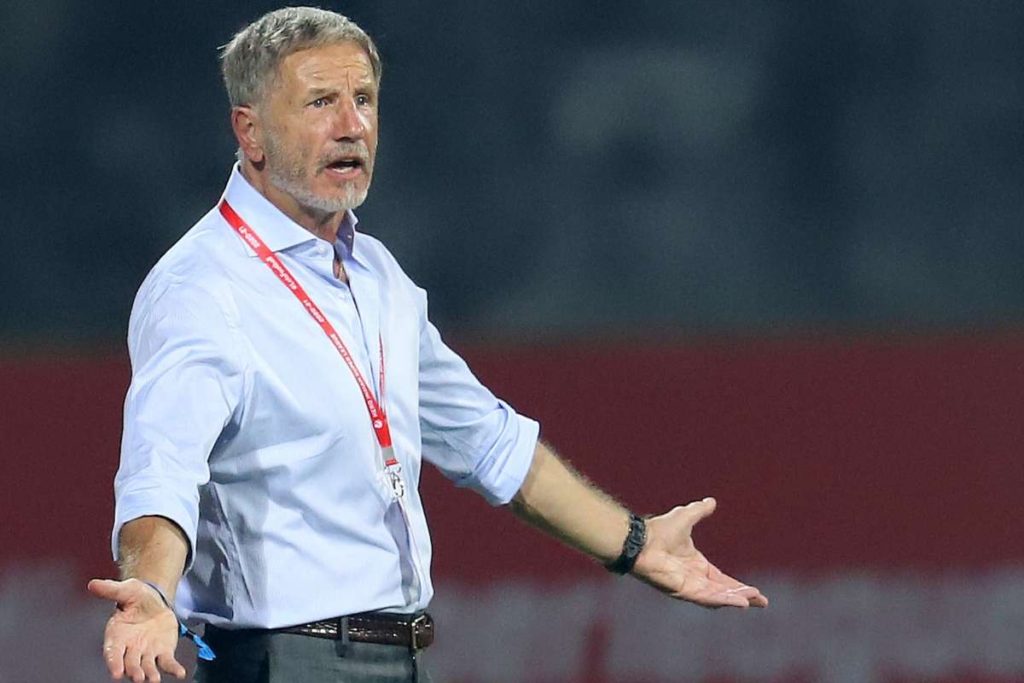
With the imminent arrival of Stuart Baxter at Kaizer Chiefs, it is important to dispel the notion that the Amakhosi side in his first spell played “helicopter” football. Here is a breakdown of his three seasons at Kaizer Chiefs.
In Baxter’s first season in 2012/13, he got Chiefs to play the most breathtaking and devastating counterattacking football South African football has ever seen. In pre-match and post-match interviews, he would emphasize the importance of transitions in unlocking stubborn defences. This led to the catchphrase “transitional play” becoming a buzzword amongst analysts and fans alike. The ball was played quickly from defense to the forwards without bypassing the midfield. Kaizer Chiefs won the title and the Nedbank Cup in his first season using the counterattacking style.
In Baxter’s second season, things got tough. Having realized the dangers of attacking Chiefs haphazardly and risking being hit on the counter, most teams chose not to commit too many players forward against them and sat deep. This led to Chiefs not finding space behind defences to take advantage of. Baxter was criticized for not adjusting his tactics when it became clear that teams would not give Chiefs space behind to exploit using their devastating transitional play. Chiefs finished second and no trophy to show for their efforts, as they could not replicate their exploits from Baxter’s maiden season.
In Baxter’s third and final season at Chiefs, something fortuitous happened at the beginning of the season that ended up having a decisive role in the title race: Bernard Parker and Siphiwe Tshabalala got injured in preseason and they would be out for up to four months.
This forced Baxter to look to his bench for players to step up during the absence of his star wide men. Enter Mandla Masango and George Lebese. Both had been squad players in the previous seasons up to that season, but when given a chance as starters at the beginning of the 2014/15 season, they played brilliantly.
Together with attacking midfielder, George Maluleka, they would form a devastating trident behind Kingston Nkhatha that was called MaLeMa by the Amakhosi faithful. Suddenly, Chiefs could hurt teams that sat back to avoid their devastating counters, as MaLeMa, with Reneilwe Letsholonyane behind them, could play quick one-twos and had the dribbling skills to unlock low blocks. Playing against Chiefs presented a dilemma for opposing teams: sit back and have the Chiefs front four pass their way around your deep lying defence or attack Chiefs and risk being countered with pace. It was a test that many teams failed to pass and by December Chiefs were running away with the league title.
Around December, both Tshabalala and Parker came back from injury and Baxter dismantled MaLeMa. Chiefs style of play immediately regressed. Chiefs no longer possessed the ability to unlock low blocks or hurt teams in transitions. When teams dropped deep, it became almost impossible to open them up as the team had lost the almost telepathic understanding of MaLeMa with Yeye and Nkhatha. Dropping MaLeMa also had another consequence: teams could attack Chiefs relentlessly without any dire consequences. Whereas three years earlier with a younger Parker and Shabba, attacking Chiefs meant opening yourself up to swift counters, this time they didn’t possess the pace on the counter to hurt teams and dissuade them from having a real go at them. Baxter had to find other ways to score.
In the second half of the season, Chiefs relied almost exclusively on set pieces to score goals as they spend the majority of games on the back foot or playing in front of set defenses with very little penetration. Their counters had lost their potency with the benching of Masango and Lebese. Mulomowandau Mathoho and Tefo Mashamaite became the primary weapons from set pieces. With a rock solid defence, Chiefs needed just one goal to secure victories and they accomplished this several times in the second round of the season. Chiefs won the MTN 8 and the League title with a then record 69 points (for a 16 team league). Baxter left after the season after disagreements with the Chiefs management on how to best refresh the squad. Chiefs have not won a trophy since.
The idea that having Nkhatha as the striker meant Chiefs played long balls to him and therefore “helicopter” football is not supported by facts. Nkhatha is short and stocky, so he was never going to win aerial balls against most centrebacks. What Nkhatha offered was brilliant hold up play to balls played to his feet. This allowed the midfield to join the attack as Nkhatha would lay off balls for players coming from deep. As a result of the hold up play, Letsholonyane scored five league goals even though he was playing in a double Pivot with Willard Katsande.
Baxter likes to organize his teams and have them playing in transitions. This does not mean his teams just kick the ball forward to some big man and hope for the best. His teams do play, even though they’re not always on the front foot. The three seasons at Chiefs showed his preferred style of play, but when circumstances forced his hand, he adapted his tactics and still achieved success.
Leave a Reply